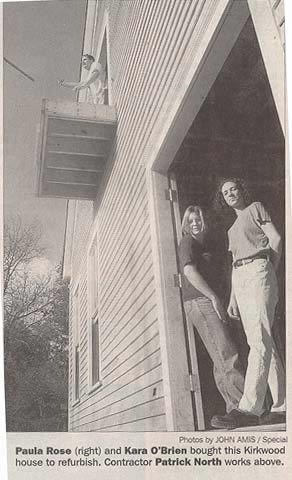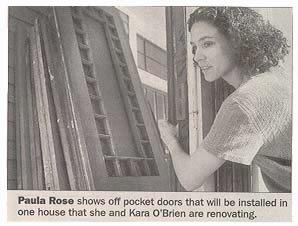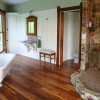
Atlanta Journal-Constitution – Pair’s Vision Enabled Avocation to Build
April 12, 2002
Pair’s Vision Enabled Avocation to Build
Private Quarters: by Tinah Saunders
Photos by John Amis/ AJC Special
 There’s a song that begins “You’ve gotta have heart.” Applied to Kara O’Brien and Paula Rose, the song begins instead, “You’ve gotta have vision.”
There’s a song that begins “You’ve gotta have heart.” Applied to Kara O’Brien and Paula Rose, the song begins instead, “You’ve gotta have vision.”
O’Brien and Rose used vision to return nine hopelessly derelict, but architecturally significant, houses to their former graciousness. The residences are in Kirkwood, a DeKalb County neighborhood within the city of Atlanta.
Their latest renovation, a pseudo Craftsman-style bungalow, one of four built by Coca-Cola Co. founder Asa Candler on Howard Street between 1893 and 1897, sold recently for $399,900. The house, now returned to its original Victorian façade, will be complete by the end of May. It then has a date with a camera crew from HGTV’s “Restore America.”
The pair, who also have day jobs-O’Brien as a writer/Web site developer with AT&T and Rose as a free-lance marketing researcher for advertising agencies-began their avocation in 1997. They bought a tiny house in the Oakhurst area, also in Atlanta-DeKalb.
“We couldn’t afford much, so we just prettied it up,” said O’Brien. “We tiled the countertops and painted and did some minor repairs.”
Their first efforts took them a year because they had no idea what they were doing, O’Brien said. The house sold quickly, and they moved on to Kirkwood where the faded beauty of a four-square Victorian with an expansive front porch caught their eye. They bought it for $135,000 in 1998.
Most of the other houses at that end of Howard Street were empty, except for vagrants and prostitutes. Shortly after they moved into the dilapidated house, a body was found in a yard nearby. Undeterred, they began what would become a five-year project.
“A neighbor who had done a lot of work on houses in the neighborhood, said we had a responsibility to a historic house, and we needed to educate ourselves about historic restoration,” O’Brien said. “So we got some magazines and books, and did.”
O’Brien and Rose used original materials where possible. They established a nationwide network of suppliers of architectural antiques to find appropriate replacements for rotted doors and windows and missing woodwork. Last month their house was appraised for $420,000.
 Along the way, they bought, renovated, and sold seven more houses, spending between one and six months on each house. Although they did a lot of the work themselves in the beginning, they have turned the labor part over to a construction crew that has become like family.
Along the way, they bought, renovated, and sold seven more houses, spending between one and six months on each house. Although they did a lot of the work themselves in the beginning, they have turned the labor part over to a construction crew that has become like family.
“We couldn’t have done it without Patrick [North] and his crew,” O’Brien said. “He’s been with us from the beginning. He started out as a painter and learned along with us. Now, he anticipates what I’d want to do in different situations and doesn’t even have to ask me.”
Their piece de resistance is the little Asa Candler house they bought in October for $49,000. Now near completion, it had been a candidate for the bulldozer that claimed neighbors on each side. An old photo of a corner of the house showed the original steep-pitched roof, a clue the residence began life as a grander home than the humble bungalow it had become.
O’Brien and Rose restored the roof and added on to the back of the house where water damage has caused the walls to collapse. Inside they salvaged original mantels and found replacements for missing fireplace tiles. They uncovered original seven-foot-tall windows and removed lowered ceilings to reveal earlier 12-foot heights.
Pocket doors with stained-glass inserts are to be installed between the living and dining rooms. And a series of matching antique stained-glass windows was added across the front of the house. The pair had a matching stained-glass transom with the house number on it made to go over the front door.
The partners are not resting on their laurels. They’ve bought another house around the corner and plan to begin work on it at the end of May. Meanwhile, they are completing blueprints for a house of their own. It’s to be built on the empty lot next door to the Victorian.
“We found the plans for an 1880’s Queen Anne in an old house plan book, and Paula taught herself [computer aided design] to bring them up to date,” O’Brien said. “It will be a completely new house but with all old parts. The goal is for people to drive by and ask, “What year was that built?”



